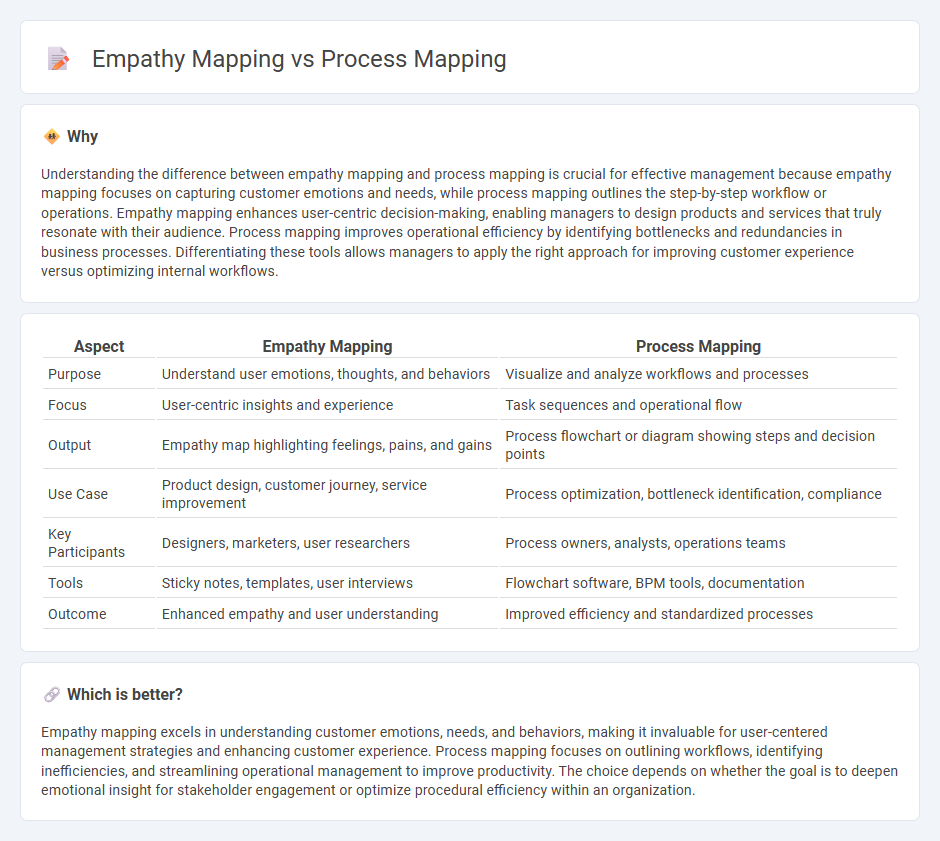
Empathy mapping focuses on understanding customer emotions, thoughts, and behaviors to enhance user experience, while process mapping outlines the specific steps and workflows within business operations for efficiency improvement. Both tools offer unique insights into organizational performance, with empathy mapping driving customer-centric strategies and process mapping streamlining internal procedures. Explore how combining these approaches can transform your management practices.
Why it is important
Understanding the difference between empathy mapping and process mapping is crucial for effective management because empathy mapping focuses on capturing customer emotions and needs, while process mapping outlines the step-by-step workflow or operations. Empathy mapping enhances user-centric decision-making, enabling managers to design products and services that truly resonate with their audience. Process mapping improves operational efficiency by identifying bottlenecks and redundancies in business processes. Differentiating these tools allows managers to apply the right approach for improving customer experience versus optimizing internal workflows.
Comparison Table
| Aspect | Empathy Mapping | Process Mapping |
|---|---|---|
| Purpose | Understand user emotions, thoughts, and behaviors | Visualize and analyze workflows and processes |
| Focus | User-centric insights and experience | Task sequences and operational flow |
| Output | Empathy map highlighting feelings, pains, and gains | Process flowchart or diagram showing steps and decision points |
| Use Case | Product design, customer journey, service improvement | Process optimization, bottleneck identification, compliance |
| Key Participants | Designers, marketers, user researchers | Process owners, analysts, operations teams |
| Tools | Sticky notes, templates, user interviews | Flowchart software, BPM tools, documentation |
| Outcome | Enhanced empathy and user understanding | Improved efficiency and standardized processes |
Which is better?
Empathy mapping excels in understanding customer emotions, needs, and behaviors, making it invaluable for user-centered management strategies and enhancing customer experience. Process mapping focuses on outlining workflows, identifying inefficiencies, and streamlining operational management to improve productivity. The choice depends on whether the goal is to deepen emotional insight for stakeholder engagement or optimize procedural efficiency within an organization.
Connection
Empathy mapping and process mapping are connected through their shared goal of enhancing user understanding and improving workflow efficiency. Empathy mapping captures user emotions, needs, and pain points, which informs process mapping by highlighting critical steps that require optimization or redesign. Together, they enable managers to create user-centered processes that boost productivity and customer satisfaction.
Key Terms
**Process Mapping:**
Process mapping visually represents workflows, detailing each step, decision point, and sequence to improve efficiency and identify bottlenecks in business operations. It employs flowcharts or diagrams to clarify processes, optimize resource allocation, and enhance communication across teams. Explore more to understand how process mapping transforms operational productivity.
Workflow
Process mapping visually outlines the step-by-step workflow of a business operation, detailing tasks, decision points, and sequences to optimize efficiency and identify bottlenecks. Empathy mapping centers on understanding the user's or customer's feelings, thoughts, and challenges throughout their journey, providing valuable insights for designing user-centric solutions. Explore more about how integrating workflow efficiency with user empathy can enhance overall process effectiveness.
Sequence
Process mapping visualizes tasks in a sequential workflow to optimize efficiency and identify bottlenecks, emphasizing the chronological order of activities. Empathy mapping centers on capturing user feelings, thoughts, and experiences rather than linear steps, offering insights into emotional journeys without a fixed sequence. Explore deeper distinctions between process and empathy mapping to enhance user-centric strategies.
Source and External Links
6 Simple Process Mapping Examples to Organize Your Work - Process mapping involves identifying the process scope, assembling a team, writing the sequence of steps, breaking down those steps, and then validating and optimizing the process to improve operational efficiency and reduce bottlenecks.
Process Mapping - Process mapping graphically shows a process's inputs, actions, and outputs, helping teams understand and improve processes by identifying strengths, weaknesses, bottlenecks, and delays through a clear, step-by-step visual map.
Process mapping guide: Definition, how-to, & examples - Process mapping visually documents workflows to clarify roles and actions, involving listing tasks and inputs, collaborating with stakeholders, arranging tasks in order, and selecting an appropriate diagram type like flowcharts or swimlane diagrams for clear communication and problem-solving.
 dowidth.com
dowidth.com